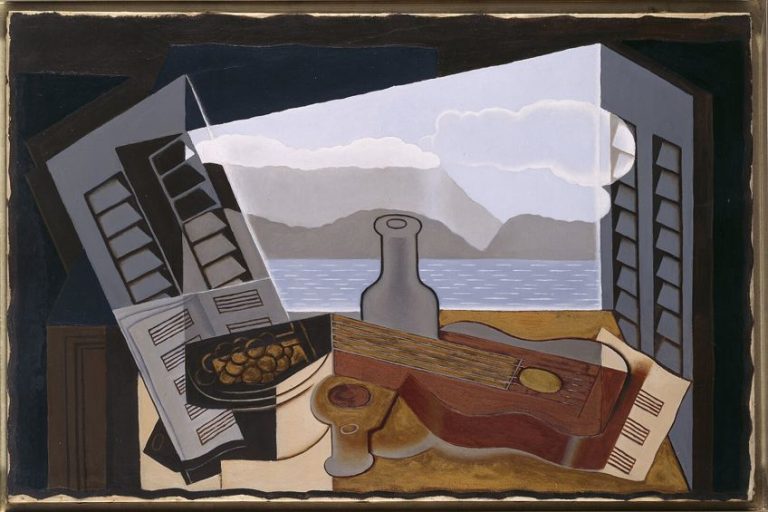The “Vitruvian Man” by Da Vinci – Famous Human Proportion Study
Imagine a drawing of a man in two superimposed poses. He stands with his arms outstretched and his legs together and apart, inscribed in a circle and a square. Maybe you have seen him before? This is the famous Vitruvian Man by Leonardo da Vinci. Below, we look at this esteemed drawing and aim to discuss in more detail the Vitruvian Man meaning.
Table of Contents
Artist Abstract: Who Was Leonardo da Vinci?
Leonardo da Vinci (1452 to 1519) was an Italian painter, engineer, inventor, draughtsman, architect, sculptor, and scientist. In fact, he was considered a polymath and a genius. Born in the city of Vinci in Italy, he was taught by the Italian artist, Andrea del Verrocchio, in Florence and worked in Milan and Rome. Da Vinci’s art is amongst the most popular masterpieces in the world, some include his famous Mona Lisa (c.1503), the Vitruvian Man (c. 1490), and The Last Supper (c. 1495 to 1498).

The Vitruvian Man by da Vinci in Context
The Vitruvian Man (c. 1490) by Leonardo da Vinci is a pen and ink drawing with surrounding notes that has become one of the artist’s most famous drawings from the Renaissance period. It is based on his studies of human proportion, symmetry, and balance, bridging the gap between art and mathematics.

In this article, we will start with some historical context about the origin of the ideas of proportion and Vitruvius himself, who inspired da Vinci to evolve these ideas further. We will then look at some of the stylistic approaches taken by Leonardo da Vinci in his portrayal of this image and what set his Vitruvian Man measurements apart from those of Vitruvius.
| Artist | Leonardo da Vinci |
| Date Painted | c. 1490 |
| Medium | Drawing (Ink on paper) |
| Genre | Design |
| Period | Italian High Renaissance |
| Dimensions | 24.5 x 34.3 centimeters |
| Series / Versions | Part of Leonardo da Vinci’s sketches and notebooks |
| Where is it housed? | Gallerie dell’Accademia, Venice, Italy |
| What It Is Worth | Not available |
Contextual Analysis: A Brief Socio-Historical Overview
You might wonder, “Why was the Vitruvian Man created?”. Well, da Vinci sought to explore the connection between man and nature through his perfect marriage of mathematics and art. This was his goal and ultimately inherent in the Vitruvian Man symbolism. Da Vinci sought to reflect the macrocosm, otherwise referred to as the universe, through the microcosm, which is the human being and vice versa.

It also touches on the Humanism philosophical and intellectual movement that was prevalent during the Renaissance time and influenced many artists including da Vinci. Renaissance Humanism explored and revived Classical ideals through Greek and Roman literature, but also art, specifically sculpture.
It also focused on the human individual’s abilities and capabilities to succeed, with many scholars and intellectuals exploring the human capacity for achievement.
It was a revolutionary new thought movement that went beyond the traditional ways of viewing the individual through the lens based on the Christian religion. It questioned man’s place in the universe. The above could be argued as deeply foundational to the Vitruvian Man symbolism and what led da Vinci to create it with so much attention to detail.
The title of Vitruvian Man by Leonardo da Vinci comes from the Italian L’Uomo Vitruviano. It is also known as Le proporzioni del corpo umano secondo Vitruvio, meaning, “The proportions of the human body according to Vitruvius”. This was based on his influence from the Roman architect and author, Marcus Vitruvius Pollio, who lived during the 1st century BC, and his treatise “On Architecture”, titled De Architectura (c. 30 to 15 BC). In Book III, Chapter 1 of his treatise, titled On Symmetry: In Temples and In the Human Body, Vitruvius also discusses human proportions.
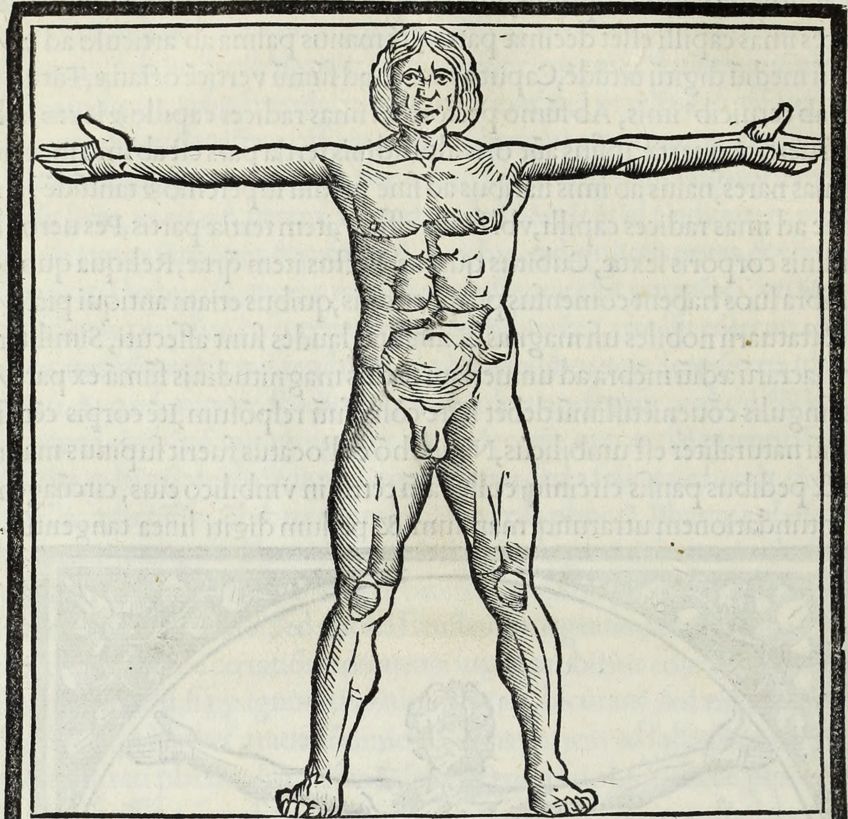
However, the matter of proportions of the human body and its study did not start with Vitruvius. A brief understanding of the origins of proportions of the human form sets the foundation for why this has been such an important focus for artists throughout European history, especially during the Renaissance era, which is when da Vinci was active as an artist, inventor, and scientist.
A Matter of Proportions
The idea of human proportions starts with what is referred to as the Canon of Proportions or occasionally Proportions of Man. This idea, for visual arts, is based on a set of ratios and measurements, that are mathematically correct, to determine the ideal proportions in which to depict the human figure and body parts.
The Canon of Proportions can be traced all the way to Ancient Egyptian times when artists used a grid to determine the ideal size for their figures, whether it was a painting or a sculpture. The grid measured, reportedly, 18 cells high. The top started at the hairline and the base started at the soles of the feet.

The Canon of Proportions also extended to Classical Greece, developed by the 5th-century sculptor called Polykleitos. He wrote a treatise, now lost, on the Kanon of Proportions, exemplified through his sculptures, according to mathematical measurements. The Greek word Kanon means “measuring rod” or “standard”.
Through this mathematical proportion, beauty was attained, and this was further explored by the Greek philosopher and surgeon called Galen (otherwise Aelius Galenus).
He wrote about beauty being in the proportions, and “not of the elements, but of the parts, that is to say, of finger to finger, and of all the fingers to the palm and the wrist, and of these to the forearm, and of the forearm to the upper arm, and of all the other parts to each other”.
Polykleitos’s bronze sculpture Doryphoros (c. 440 BC), also referred to as the “Spear-Bearer”, which has been lost and reproduced as a marble copy during the Roman period, is an example of the above-mentioned proportional symmetry, or Canon, of the male figure, depicted through the means of art, in this case, sculpture.
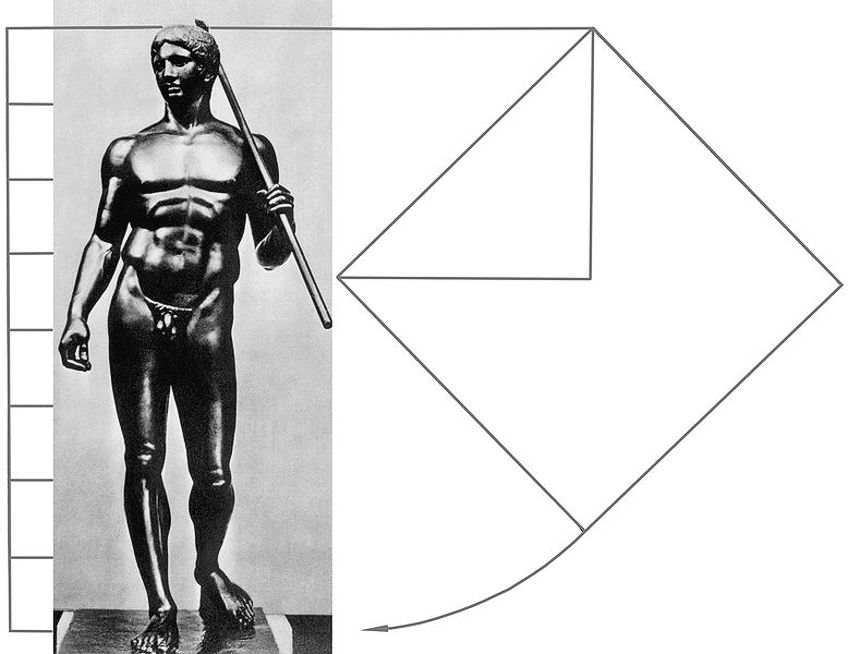
Who Was Vitruvius?
This brings us to Vitruvius, another proponent of proportion, not only in the human figure but in architecture. His treatise, De Architectura (c. 30 to 15 BC), was published in several languages after it was “rediscovered” in 1414 by the Italian scholar and Humanist, Poggio Bracciolini. This led to it being widely distributed, influencing numerous Renaissance artists and architects.
Vitruvius compiled his treatise into several volumes and dedicated it to Emperor Augustus. He based his work on three dominant principles and attributes related to building, namely, firmitatis (“stability”), utilitatis (“utility”), and venustatis (“beauty”). These have also been referred to as the “Vitruvian Triad”.
An important point to remember is that Vitruvius conveyed the essence of nature in how buildings were built.
Additionally, he explored the perfection of proportion in the human form, which inspired Leonardo da Vinci to draw what Vitruvius started. In Vitruvius’s text, he wrote that the proportions of the human figure were like that of a temple and that all parts of the human body are “measures of the whole”.
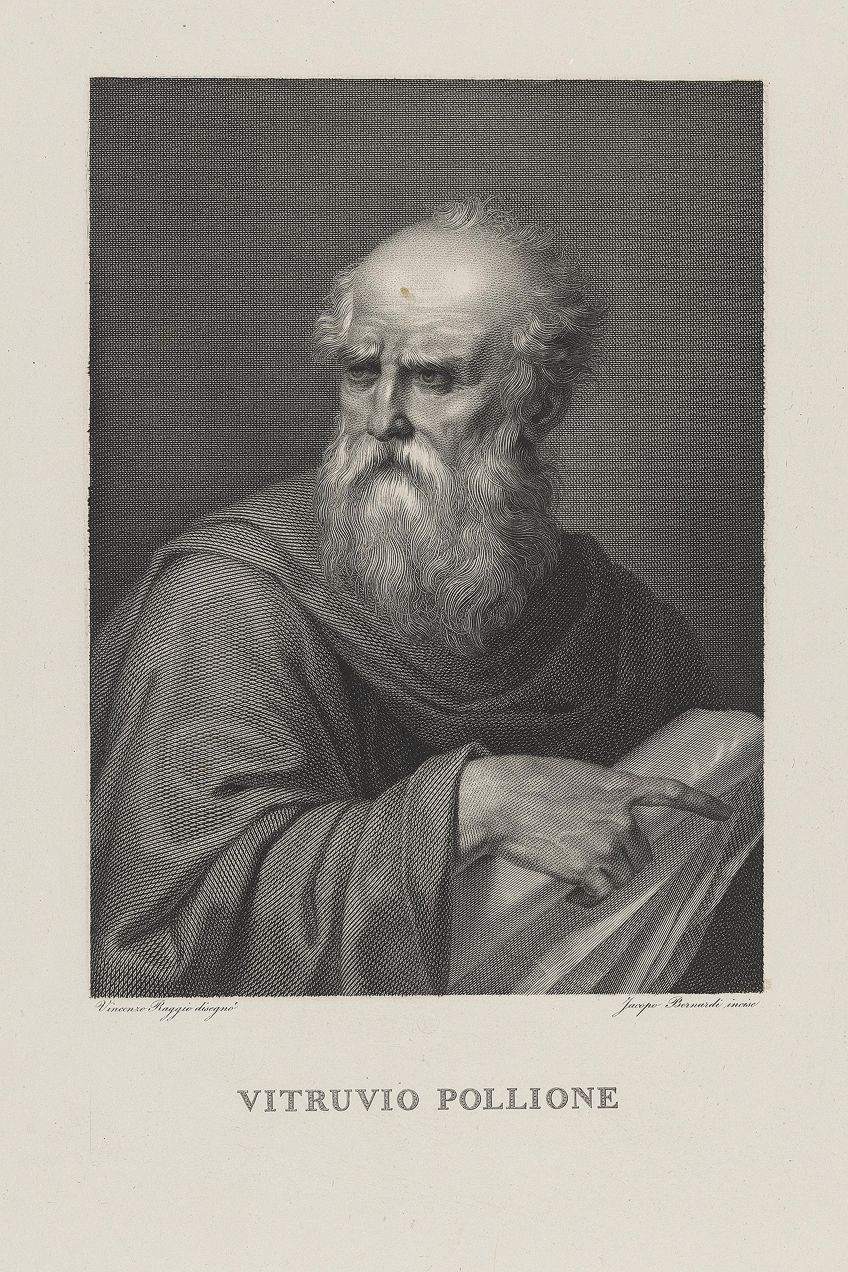
He further explained that all measures used in buildings derived from that of the human body, for example, “the digit, the palm, the foot, the cubit”. He also explained that ten was considered a perfect number by the ancients because “the fingers are ten in number, and the palm is derived from them, and from the palm is derived the foot”.
In paragraph three of Book III, Chapter 1, Vitruvius described the proportions of the human body, explaining in detail the different body parts and their consecutive measurements are. For example, “From the chin to the crown of the head is an eighth part of the whole height, and from the nape of the neck to the crown of the head the same”.
He continues to describe in detail the different measurements from the upper breast, roots of the hair, the top of the head, and the feet.

He further described his explanation of how these above-mentioned proportions of the human body correspond with a circle and square, and he compares it to how proportions in a temple correspond with the other. “The navel is naturally placed in the center of the human body, and, if in a man lying with his face upward, and his hands and feet extended, from his navel as the center, a circle is described, it will touch his fingers and toes”.
He further explains how the human body will fit in a square: “We find the latter measure equal to the former; so that lines at right angles to each other, enclosing the figure, will form a square”.
A Symbol of Ideal Proportions: What da Vinci Did Differently
Leonardo da Vinci sought to copy Vitruvius’s estimated proportions and did so in a sketch, although he was not the only one during that time to copy these famed proportions. There were differences in the proportions that da Vinci drew, which not only showed his wholly innovative and genius mind but also improved the mathematical accuracy.
He veered away from a direct copy of Vitruvius’s descriptions and drew the center of the navel in different positions in both the circle and the square; the square’s center was situated at the groin.

He also drew the arms in a different position, and explained the following, in the notes he made on the top part of the piece of paper with the drawing on it, “If you open your legs enough that your head is lowered by one-fourteenth of your height and raise your hands enough that your extended fingers touch the line of the top of your head, know that the center of the extended limbs will be the navel, and the space between the legs will be an equilateral triangle”.
Other Versions of the Vitruvian Man
It is also reported that da Vinci collaborated with two other artists of the time, also referred to as his colleagues, they were, namely, Francesco di Giorgio Martini and Giacomo Andrea. The latter was possibly an influence on and close friend of da Vinci at the time.
The first drawings were done during the 1480s by Francesco di Giorgio Martini; there are three examples that illustrate Vitruvius’s descriptions. These are not mathematically accurate, however, and merely suggest in visual form Vitruvius’s ideas. However, one out of the three depicts a more mathematically correct illustration with the body of a man within a church plan design.

Two of his other drawings depict a man standing casually with his outstretched arms, the one is of him in front of a building and the other of him in a circle and square superimposed on the other. The stance of Martini’s Vitruvian Man is very relaxed, and his hips are higher at one side than the other, suggestive of a typical contrapposto stance.
Giacomo Andrea also made a Vitruvian Man drawing; however, the circle was higher than the square, compared to Giorgio’s version mentioned above. This in turn made the navel central in the circle and the groin central in the square. The man is depicted as standing with both legs together and his arms are outstretched, palms up at either side of the square and circle.
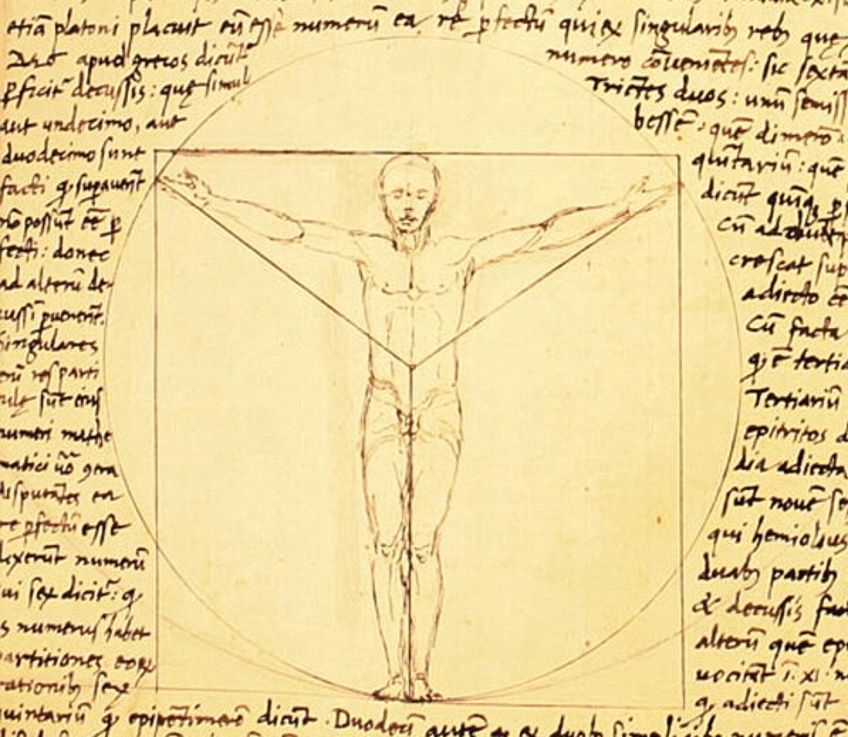
Formal Analysis: A Brief Compositional Overview
Below we will discuss Leonardo da Vinci’s Vitruvian Man and its stylistic elements. As we see from the above-mentioned examples of Giorgio and Andrea’s versions, da Vinci’s version has a great deal of depth and detail that sets it apart.
Subject Matter
As we see in da Vinci’s Vitruvian Man, he drew a male figure, superimposed, standing in two different postures. In the previously mentioned examples, there was only one figure depicted. Looking at the way da Vinci drew the postures, the man standing with his feet together and arms outstretched straight in line with his shoulders is in line with the square.
The other posture shows his feet and arms in a spread-eagle posture, this stance also makes the equilateral triangle he mentioned in his notes. His arms are slightly above his shoulders here, reaching to show where it touches the circle.

We will also notice the circle and square here, like the version Giacomo Andrea drew. The top part of the circle is also raised slightly above the square, which will make the navel centralized in the circle and the groin centralized in the square.
There appears to be a great deal of care taken by da Vinci to delineate the drawing.
Not only is his circle and square meticulously done, but the actual figure of the “Vitruvian Man” is rendered almost like one of da Vinci’s figures from his paintings. We see the human anatomy and anatomical correctness in every body part of the male’s figure, from his arm muscles, leg muscles, torso, and the minute details depicted in his face and curly hair.
If we look at his face, we will notice a serious and quite intense stare forward and simultaneously neutral, as if he is gazing as a model being painted or as some sources describe, as “intense as someone looking in a mirror”.

It is believed this was a self-portrait by da Vinci, expanded on by the author and historian Toby Lester, who describes in his book, Da Vinci’s Ghost (2012), that the figure’s face is an “idealized self-portrait in which Leonardo, stripped down to his essence, takes his own measure”. Lester continued to explain that the drawing is almost like a “kind of metaphysical self-portrait in which Leonardo – as an artist, a natural philosopher, and a stand-in for all humanity – peers at himself with furrowed brow and tries to grasp the secrets of his own nature”.
Technique: Color, Light, and Texture
Leonardo da Vinci also utilized stylistic elements like the shading in different areas of the body to suggest more depth and three-dimensionality. Remember this is a drawing done in ink, showing another level of da Vinci’s artistic skills and level of detail he achieved working with almost any medium, be it paint or ink.
We see shading in various parts of the Vitruvian physique and behind it on the piece of paper with the cross-hatching technique.
For example, in the gentle and natural cupping of the hands, just under the armpit area, the base of the feet, more notably under his inner right (our left) foot, the neck area, and the face. We see the delicate shading work done under the eyes and around wrinkled areas.
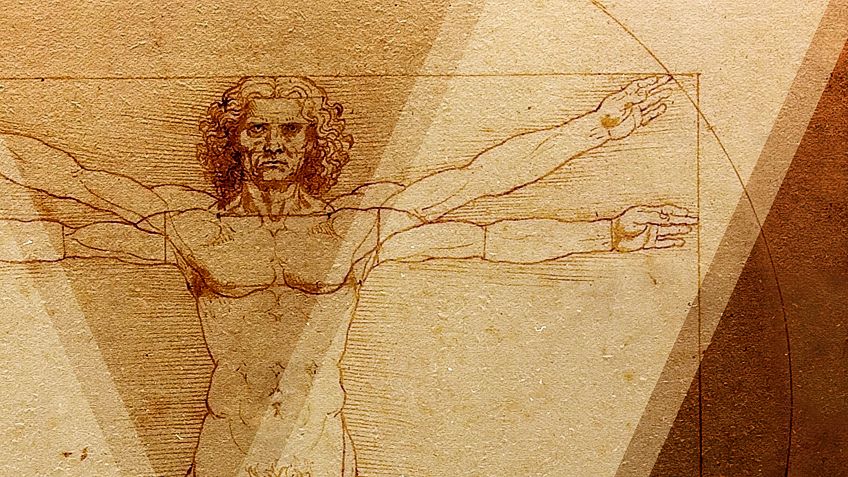
Perspective and Scale
Even working with simple ink on paper, da Vinci manages to create three-dimensionality with this Vitruvian physique. Furthermore, the superimposed image within the limited confines of the circle and square creates a sense of movement with its several limbs. Some sources also liken it to his “four-winged dragonflies” that he studied.
The “Vitruvian Man” measurements have been applied in contemporary times too, various sources indicate contemporary measurement tests done on males and females.
The results were close to the Vitruvian Man by da Vinci; some proportions in men were reportedly ten percent within the Vitruvian Man measurements. A team who was part of a testing group under Diana Thomas, a mathematician from the U.S. Military Academy in West Point, New York, reported about the tests done and said, “Despite the different samples and methods of calculation, Leonardo da Vinci’s ideal human body and the proportions obtained with contemporary measurements were similar”.

Science and Beauty Envisioned
The Vitruvian Man drawing was found amongst Leonardo da Vinci’s other sketches and notebooks, and he probably did not draw this for the same purposes he painted, the latter being for public display. The Vitruvian Man has become a sensation since its discovery and a reminder of the beauty inherent in science and vice versa.
Da Vinci and his Vitruvian Man have become an icon over the centuries, not only in Western art but in our 21st-century pop culture. We see him on various memorabilia and merchandise, in films, T-shirt designs, books, and even music. He has been immortalized within the circle and square, a geometric and beautiful vestige of ideal proportions.
Take a look at our Vitruvian Man webstory here!
Frequently Asked Questions
What Is the Vitruvian Man?
The Vitruvian Man (c. 1490) is a pen and ink drawing done by Leonardo da Vinci (and other artists) who was a polymath from the High Renaissance period. It is based on his studies of human proportion that were described in the treatise De Architectura (c. 30 to 15 BC), “On Architecture”, by the Roman architect and author, Marcus Vitruvius Pollio, from the 1st century BC.
Why Was the Vitruvian Man Created?
The Vitruvian Man meaning is about connecting man to nature, this was Leonardo da Vinci’s goal and ultimately the Vitruvian Man symbolism. Da Vinci sought to depict the microcosm, so to say, through the human being, and in turn, this reflected the macrocosm, which refers to the universe.
Where Is the Vitruvian Man Now?
The Vitruvian Man drawing is housed in the museum Gallerie dell’Accademia in Venice, Italy. It is displayed on occasion to preserve its quality and minimize exposure to as much light as possible. It was also part of an exhibition about Leonardo da Vinci at the Louvre in Paris, France from 24 October 2019 to 24 February 2020.
Alicia du Plessis is a multidisciplinary writer. She completed her Bachelor of Arts degree, majoring in Art History and Classical Civilization, as well as two Honors, namely, in Art History and Education and Development, at the University of KwaZulu-Natal, South Africa. For her main Honors project in Art History, she explored perceptions of the San Bushmen’s identity and the concept of the “Other”. She has also looked at the use of photography in art and how it has been used to portray people’s lives.
Alicia’s other areas of interest in Art History include the process of writing about Art History and how to analyze paintings. Some of her favorite art movements include Impressionism and German Expressionism. She is yet to complete her Masters in Art History (she would like to do this abroad in Europe) having given it some time to first develop more professional experience with the interest to one day lecture it too.
Alicia has been working for artincontext.com since 2021 as an author and art history expert. She has specialized in painting analysis and is covering most of our painting analysis.
Learn more about Alicia du Plessis and the Art in Context Team.
Cite this Article
Alicia, du Plessis, “The “Vitruvian Man” by Da Vinci – Famous Human Proportion Study.” Art in Context. September 28, 2021. URL: https://artincontext.org/the-vitruvian-man-da-vinci/
du Plessis, A. (2021, 28 September). The “Vitruvian Man” by Da Vinci – Famous Human Proportion Study. Art in Context. https://artincontext.org/the-vitruvian-man-da-vinci/
du Plessis, Alicia. “The “Vitruvian Man” by Da Vinci – Famous Human Proportion Study.” Art in Context, September 28, 2021. https://artincontext.org/the-vitruvian-man-da-vinci/.









